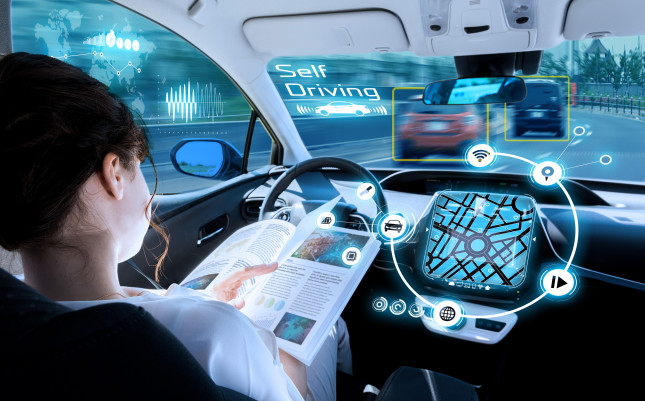-
China’s Race to Develop Autonomous Vehicles
February 28, 2019 By Xiaomei Tan
Autonomous vehicles (AVs) are revving up in China. As part of the 2018 CCTV Spring Festival Gala, more than one hundred AVs swerved perfect 8’s on the Hong Kong-Zhuhai-Macao Bridge, showcasing Baidu Apollo’s latest AV technology. China is a latecomer to the automotive industry, but it is taking the wheel in autonomous driving technologies and electric and hydrogen cars, viewing the sector as an unprecedented opportunity to play catchup with the rest of the world (See China Environment Forum webinar on China’s new energy vehicle trends below). Companies in China and around the world want to tap into the lucrative autonomous technology market that could reach $2.3 trillion by 2030.
In the United States, prototype AVs have been developing at a high speed since first hitting the roads in 2012. GM is set to launch robotaxi services in 2019, but is behind Uber, whose self-driving robotaxi regularly ferries riders around in Pittsburgh and Phoenix, usually with one safety engineer ready to hit the brakes. Waymo, an Alphabet company, has successfully operated truly autonomous minivans in a suburb of Phoenix.
All of these developments have led to monumental change in the international automotive industry. The global value chain and profit pools are undergoing massive shifts. Specifically, traditional automakers are being forced to share a piece of the automotive-industry pie with tech giants such as Alphabet, Apple, and Alibaba, as well as ride-sharing companies like Uber, Didi and Zipcar. Competing head-to-head with these players are new automotive entrants, such as Tesla and BYD.
China is working fast to make the necessary investments to encourage technological innovation around autonomous vehicles to ensure that it stays ahead of the international curve. While this kind of technological development is key, sustainable success of the AV industry in China will depend on whether Chinese policymakers can create policies and regulatory frameworks that encourage investments and innovation in the supporting infrastructure that make it safe and acceptable to the public.
China’s National AV Roadmap
On July 2017, China’s State Council issued the “New Generation Artificial Intelligence Development Plan,” outlining an ambitious roadmap for China to lead the artificial intelligence sector, prioritizing the development of AVs as a “strategic frontier.” Five months later, the Ministry of Industry and Information Technology (MIIT) enhanced the roadmap by announcing the Three-Year Plan for Promoting Development of a New Generation Artificial Intelligence Industry (2018–2020). The action plan includes plans to develop key technological components of AVs, such as automotive smart chips, vehicle intelligence algorithms, and advanced driver assistant systems.
After announcing AVs as a technology development priority, China started formulating a regulatory framework to guide and support the growth of the industry. In 2016, MIIT led a working group composed of National Academy of Standardization and a number of industrial associations to kick off the formulation of a national standards system. The following year, draft guidelines were published for public comments.
On June 16, 2018, the final set of guidelines were published by MIIT. The guidelines for communication and electronics sectors are particularly detailed, including stipulations for vehicles, communication, electronics, transportation, and public safety. They include:
- Overall guidelines to establish a National Standard System for the Telematics Industry
- Regulations for communication technologies
- Management for electronic products and services
The communication guidelines cover 92 standards, with a special focus on 5G V2X technology and LTE-V technology. The 92 standards are categorized into three “layers:” cloud, pipe, and end. The bottom layer, “end,” is the terminal system covering V2X communication equipment, vehicle communication gateway, roadside communication infrastructure, and personal portable communication devices. The middle layer, “pipe” makes communication happen. Through V2X and cellular network communication, the pipe enables vehicle-to-infrastructure, vehicle-to-vehicle, vehicle-to-pedestrian, vehicle-to-device, and vehicle-to-grid connectivity. The “cloud” layer provides comprehensive information and service platforms, covering business platform, data platform and supporting architecture. The figure below illustrates the standard system for communication technology.

The electronics guidelines cover 84 standards, which are grouped into five categories – basic products, terminal devices, networks, platforms, and services. The following chart illustrates the 84 standards. Deadlines have already been set for all the standards. More than 30 key standards that are critical to advanced driver-assistance systems and low-level autonomous driving will be defined by 2020 and a system of over 100 standards for higher level autonomous driving will be set by 2025.
While the national-level regulations are still developing, local governments already started competing to be the first cities to allow autonomous vehicle road testing. In Feb. 2018, Beijing issued the Administrative Measures on Road Testing for Intelligent Connected Vehicles (ICV). Shanghai immediately followed and went one step further by releasing AV testing permits. Several other cities including Chongqing, Shenzhen, Changchun, Changsha, and Pingtan all published AV road testing regulations before the National Rules were released by MIIT, the Ministry of Public Security, and the Ministry of Transport in April 2018. An important question regarding these many regulations is which will prevail if local rules do not agree with the national rules. Currently, there is no clear answer.
What’s Next?
After the Guidelines were released, China announced the Action Plans for Intelligent Connected Vehicles (ICV) Industry Development. The plans called for cross-sectoral cooperation in ICV infrastructure development to accelerate autonomous driving technology’s market penetration. The government’s plans also proposed to demonstrate ICV zones in major airports, industrial parks, and ports across the country. According to the Plans, local governments should increase their budgetary support for the industry and at the same time encourage social capital’s involvement.
From roadmap to standard-setting guidelines to action plans, China’s approach to AV development is systematic. This systematic approach reflects what the Chinese policymakers called “top-level design” which views the government as the chief designer of the overall economy or a specific sector. However, regulating new technology is difficult, especially if the technology advances quickly and involves numerous evolving stakeholders. As Chris Urmson of Aurora said: “It is important that we don’t leap to regulation before we actually have something to regulate.” Otherwise, regulation could inhibit innovation. The key here is for the government to work closely with the AV industry to ensure relevance and flexibility, so AV policies can translate from paper to the roads. When asked by China Daily to comment on China’s AV standard-setting guidelines, Volvo CEO and President, Hakan Samuelsson said it would be good to start with guidelines, then the regulations can work hand in hand with technology as we learn exactly how these cars can work in traffic. How this “hand in hand” proposal works out will determine if China’s top-level design for AV development will succeed or fail.
Xiaomei Tan is the Senior Urban and Transport Specialist at GEF Trust Fund, World Bank Group.
Sources: China Daily, China Science & Technology Newsletter, Economist, Ministry of Industry and Information Technology, South China Morning Post, ST.com.
Credit for in-text images: National Autonomous Vehicles Standard Guideline by Ministry of Industry and Information Technology.
Lead image via Shutterstock. All rights reserved.
Topics: Asia, China, China Environment Forum, energy, environment, Infrastructure, mobile technology
 A Publication of the Stimson Center.
A Publication of the Stimson Center.


 Source: National Autonomous Vehicles Standard Guideline by Ministry of Industry and Information Technology.
Source: National Autonomous Vehicles Standard Guideline by Ministry of Industry and Information Technology. 




